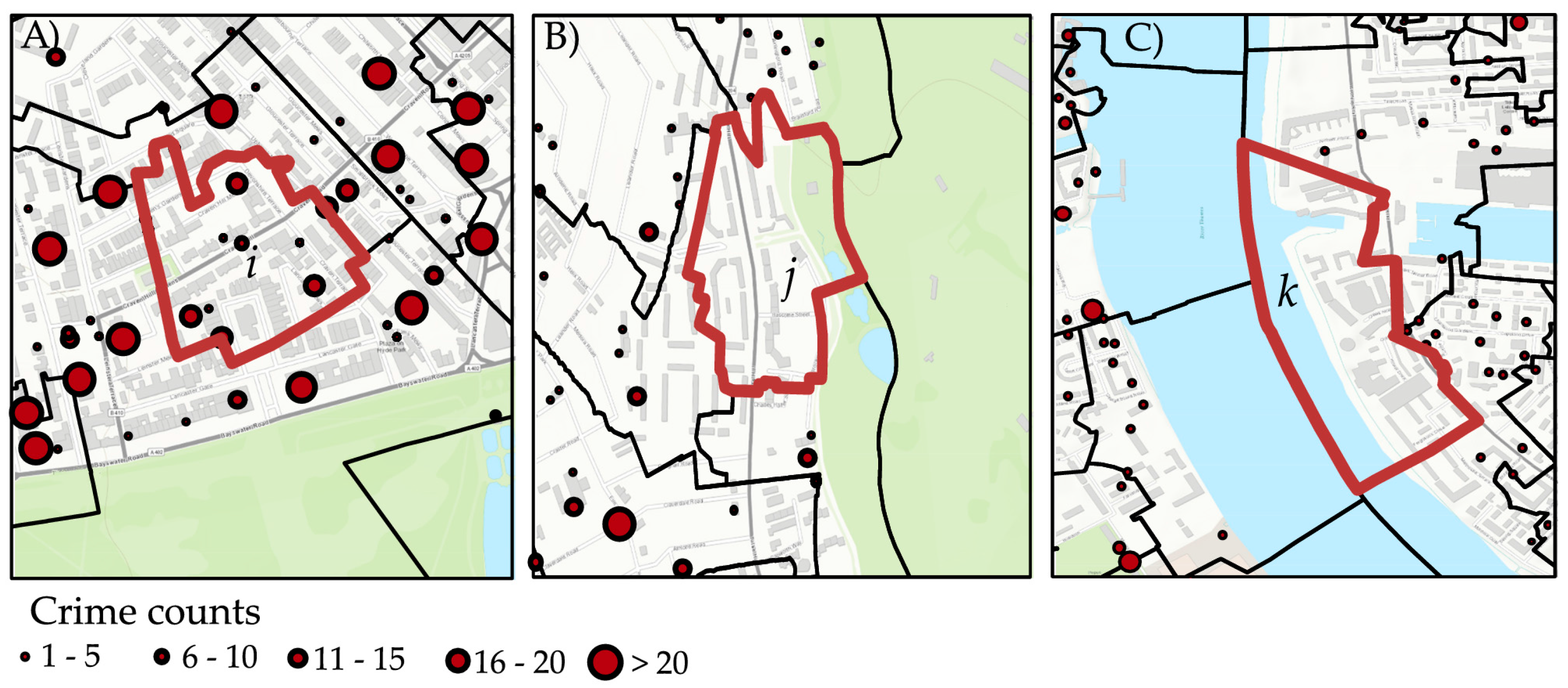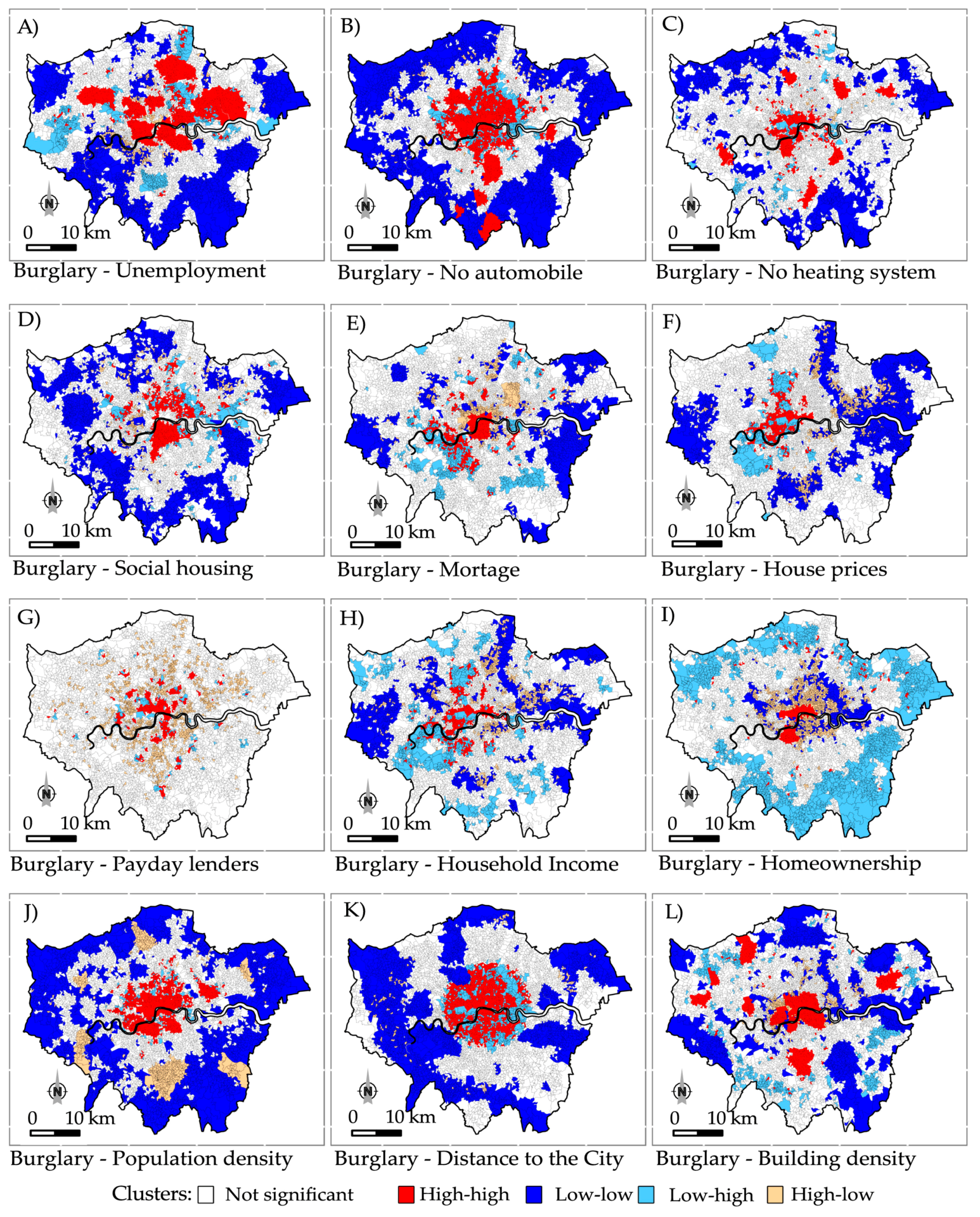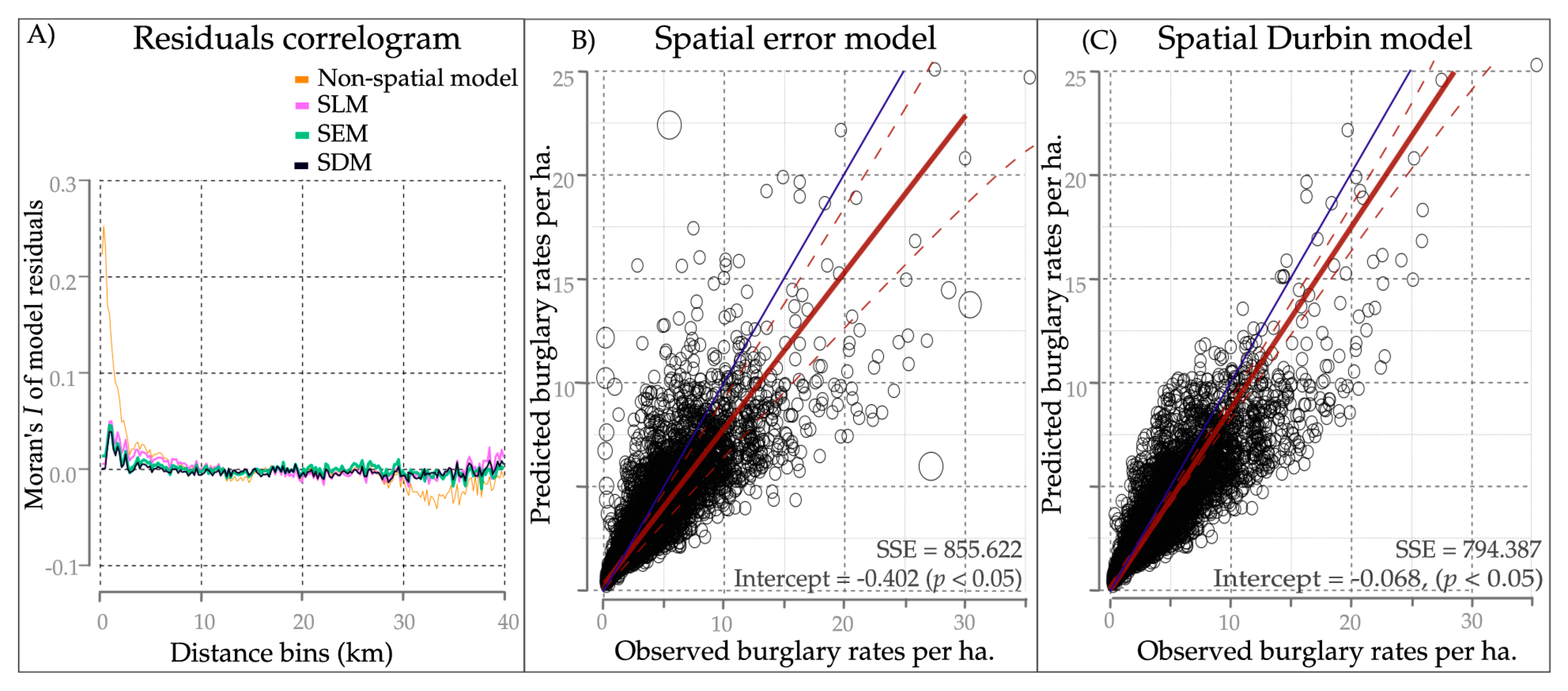Modeling Spatial Interactions between Areas to Assess the Burglary Risk
Abstract
:1. Introduction
2. Area-Based Burglary Influences
- To what extent does the spatial arrangement of areas mediate the structural influence on an area’s internal burglary risk?
- How do risk factors of interconnected areas affect the cumulative burglary frequency?
3. Materials and Methods
3.1. Study Area
3.2. Data and Variables
3.3. Methods
4. Results
4.1. Exploratory Analysis
4.2. Detecting Spatial Clusters
4.3. Regression Analysis
5. Discussion
6. Conclusions
Acknowledgements
Author Contributions
Conflicts of Interest
Abbreviations
| ONS | Office for National Statistics |
| LISA | Local indicators of spatial autocorrelation |
| OLS | Ordinary least squares |
| SLM | Spatial lag model |
| SEM | Spatial error model |
| SDM | Spatial Durbin model |
| MCMC | Markov’s Chain Monte Carlo |
| AIC | Akaike Information Criteria |
| SC | Schwarz criterion |
| MAUP | Modifiable areal unit problem |
References
- Bernasco, W.; Luykx, F. Effects of attractiveness, opportunity and accessibility to burglars on residential burglary rates of urban neighborhoods. Criminology 2003, 41, 981–1002. [Google Scholar] [CrossRef]
- Hirschfield, A.; Birkin, M.; Brunsdon, C.; Malleson, N; Newton, A. How places influence crime: The impact of surrounding areas on neighbourhood burglary rates in a British city. Urban Stud. 2013. [Google Scholar] [CrossRef]
- Elffers, H. Analysing neighbourhood influence in criminology. Stat. Neerlandica 2003, 57, 347–367. [Google Scholar] [CrossRef]
- Anselin, L.; Raymond, F. New Directions in Spatial Econometrics; Springer: New York, NY, USA, 2012. [Google Scholar]
- Bowers, K. Risky facilities: Crime radiators or crime absorbers? A comparison of internal and external levels of theft. J. Quant. Criminol. 2014, 30, 389–414. [Google Scholar] [CrossRef]
- Mburu, L.; Helbich, M. Crime risk estimation with a commuter-harmonized ambient population. Ann. Assoc. Am. Geogr. 2016. [Google Scholar] [CrossRef]
- Brantingham, P.J.; Brantingham, P.L. Environmental Criminology; Sage Publications: Beverly Hills, CA, USA, 1981. [Google Scholar]
- Eck, J.E.; Weisburd, D.L. Crime places in crime theory. In Crime and Place: Crime Prevention Studies; Willow Tree Press, Inc.: Monsey, NY, USA, 2015; pp. 1–33. [Google Scholar]
- Yu, S.S.V.; Smith, M.J. Areas where vulnerable public transit commuters reside: A method for targeting crime prevention and other resources to address local area problems. In Safety and Security in Transit Environments; Ceccato, V., Newton, A., Eds.; Palgrave Macmillan: New York, NY, USA, 2015; pp. 213–233. [Google Scholar]
- Miller, J.; Caplan, J.M.; Ostermann, M. Home nodes, criminogenic places, and parolee failure: Testing an environmental model of offender risk. Crime Delinq. 2013, 62, 169–199. [Google Scholar] [CrossRef]
- Wright, R.T.; Decker, S.H. Burglars on the Job: Streetlife and Residential Break-Ins; Northeastern University Press: Boston, MA, USA, 1996. [Google Scholar]
- Malleson, N.; Heppenstall, A.; See, L. Crime reduction through simulation: An agent-based model of burglary. Comput. Environ. Urban Syst. 2010, 34, 236–250. [Google Scholar] [CrossRef]
- Sampson, R.J.; Raudenbush, S.W.; Earls, F. Neighborhoods and violent crime: A multilevel study of collective efficacy. Science 1997, 277, 918–924. [Google Scholar] [CrossRef] [PubMed]
- Sutherland, A.; Brunton-Smith, I.; Jackson, J. Collective efficacy, deprivation and violence in London. Br. J. Criminol. 2013. [Google Scholar] [CrossRef]
- Johnson, L.T.; Taylor, R.B.; Groff, E.R. Metropolitan local crime clusters: Structural concentration effects and the systemic model. J. Crim. Justice 2015, 43, 186–194. [Google Scholar] [CrossRef]
- Shaw, C.R.; McKay, H.D. Juvenile Delinquency and Urban Areas. Criminology Theory; University of Chicago Press: Chicago, IL, USA, 1969. [Google Scholar]
- Sampson, R.J. Structural density and criminal victimization. Criminology 1983, 21, 276–293. [Google Scholar] [CrossRef]
- Kocsis, R.N.; Irwin, H.J. An analysis of spatial patterns in serial rape, arson, and burglary: The utility of the circle theory of environmental range for psychological profiling. Psychiatry Psychol. Law 1997, 4, 195–206. [Google Scholar] [CrossRef]
- Brantingham, P.; Glässer, U.; Jackson, P.; Vajihollahi, M. Modeling Criminal Activity in Urban Landscapes; Springer: Vienna, Austria, 2009. [Google Scholar]
- Mawby, R. Burglary; Routledge: London, UK, 2013. [Google Scholar]
- Johnson, S.D.; Bowers, K.J. The stability of space-time clusters of burglary. Br. J. Criminol. 2004, 44, 55–65. [Google Scholar] [CrossRef]
- Vandeviver, C.; van Daele, S.; Vander Beken, T. What makes long crime trips worth undertaking? Balancing costs and benefits in burglars’ journey to crime. Br. J. Criminol. 2014. [Google Scholar] [CrossRef]
- Farrell, G.; Pease, K. Once Bitten, Twice Bitten: Repeat Victimisation and Its Implications for Crime Prevention; Paper No. 46; Home Office: London, UK, 1993. [Google Scholar]
- Townsley, M.; Homel, R.; Chaseling, J. Infectious burglaries. A test of the near repeat hypothesis. Br. J. Criminol. 2003, 43, 615–633. [Google Scholar] [CrossRef]
- Ward, J.T.; Nobles, M.R.; Youstin, T.J.; Cook, C.L. Placing the neighborhood accessibility-burglary link in social-structural context. Crime Delinq. 2010, 60, 739–763. [Google Scholar] [CrossRef]
- Grubesic, T.H.; Mack, E.A. Spatio-temporal interaction of urban crime. Quant. Criminol. 2008, 24, 285–306. [Google Scholar] [CrossRef]
- Leitner, M.; Kent, J. Bayesian journey-to-crime modelling of single and multiple crime-type series in Baltimore County, MD. J. Invest. Psychol. Off. 2009, 6, 213–236. [Google Scholar] [CrossRef]
- Mburu, L.; Helbich, M. Evaluating the accuracy and effectiveness of criminal geographic profiling methods: The case of Dandora, Kenya. Prof. Geogr. 2015, 67, 110–120. [Google Scholar] [CrossRef]
- Walker, W.C.; Sim, S.; Keys-Mathews, L. Use of geographically weighted regression on ecology of crime, response to hurricane in Miami, Florida. In Forensic GIS; Springer: Netherlands, 2014; pp. 245–262. [Google Scholar]
- Browning, C.R.; Byron, R.A.; Calder, C.A.; Krivo, L.J.; Kwan, M.P.; Lee, J.Y.; Peterson, R.D. Commercial density, residential concentration, and crime: Land use patterns and violence in neighborhood context. J. Res. Crime Delinq. 2010, 47, 329–357. [Google Scholar] [CrossRef]
- Leitner, M.; Helbich, M. The impact of hurricanes on crime: A spatio-temporal analysis in the city of Houston, Texas. Cartogr. Geogr. Inf. Sci. 2011, 38, 213–221. [Google Scholar] [CrossRef]
- Montoya, L.; Junger, M.; Ongena, Y. The relation between residential property and its surroundings and day-and night-time residential burglary. Environ. Behav. 2014. [Google Scholar] [CrossRef]
- Stults, B.J.; Hasbrouck, M. The effect of commuting on city-level crime rates. Quant. Criminol. 2015, 31, 331–350. [Google Scholar] [CrossRef]
- Hipp, J.R. Spreading the wealth: The effect of the distribution of income and race/ethnicity across households and neighborhoods on city crime trajectories. Criminology 2011, 49, 631–665. [Google Scholar] [CrossRef]
- Bowers, K.J.; Hirschfield, A.; Johnson, S.D. Victimization revisited: A case study of non-residential repeat burglary on merseyside. Br. J. Criminol. 1998, 38, 429–452. [Google Scholar] [CrossRef]
- Cromwell, P.F.; Olson, J.N.; Avary, D.W. Breaking and Entering: An Ethnographic Analysis of Burglary; Sage: Newbury Park, CA, USA, 1991. [Google Scholar]
- Bean, P. Drugs and Crime; Routledge: London, UK, 2014. [Google Scholar]
- Groff, E.R.; Lockwood, B. Criminogenic facilities and crime across street segments in Philadelphia uncovering evidence about the spatial extent of facility influence. J. Res. Crime Delinq. 2014, 51, 277–314. [Google Scholar] [CrossRef]
- Pointer, G. The UK’s Major Urban Areas. Focus on People and Migration. Available online: www.statistics.gov.uk/downloads/theme_compendia/fom2005/03_FOPM_UrbanAreas.pdf (accessed on 15 March 2016).
- Palmer, G. The Poverty Site: U.K Income Inequalities. 2011. Available online: http://www.poverty.org.uk/09/index.shtml? (accessed on 15 March 2016).
- Office for National Statistics. The 2013 ONS Regional Characteristics Analysis for London. Available online: http://www.ons.gov.uk/ons/rel/regional-trends (accessed on 15 March 2016).
- Office for National Statistics. Statistical Bulletin: Crime in England and Wales: Year Ending June 2015. Available online: http://www.ons.gov.uk/peoplepopulationandcommunity/crimeandjustice/bulletins/crimeinenglandandwales/2015-10-15 (accessed on 29 March 2016).
- Payne, R.; Abel, G. UK indices of multiple deprivation—A way to make comparisons across constituent countries easier. Health Stat. Q. 2012, 53, 22–37. [Google Scholar]
- Brown, J. 10 London Boroughs Worth More Than All the Homes in Wales, Scotland and Northern Ireland. Available online: http://www.independent.co.uk/news/uk/home-news/10-london-boroughs-worth-more-than-all-the-homes-in-wales-scotland-and-northern-ireland-8478990.html (accessed on 15 March 2016).
- Vandeviver, C.; Neutens, T.; van Daele, S.; Geurts, D.; Vander Beken, T. A discrete spatial choice model of burglary target selection at the house-level. Appl. Geogr. 2015, 64, 24–34. [Google Scholar] [CrossRef]
- Morse, A. Payday lenders: Heroes or villains? J. Financ. Econ. 2011, 102, 28–44. [Google Scholar] [CrossRef]
- Posick, C.; Rocque, M.; Whiteacre, K.; Mazeika, D. Examining metal theft in context: An opportunity theory approach. Justice Res. Policy 2012, 14, 79–10. [Google Scholar] [CrossRef]
- Moreto, W.D.; Piza, E.L.; Caplan, J.M. “A plague on both your houses?”: Risks, repeats and reconsiderations of urban residential burglary. Justice Q. 2014, 31, 1102–1126. [Google Scholar] [CrossRef]
- Johnson, L.T.; Taylor, R.B.; Ratcliffe, J.H. Need drugs, will travel?: The distances to crime of illegal drug buyers. J. Crim. Justice 2013, 41, 178–187. [Google Scholar] [CrossRef]
- Tita, G.E.; Radil, S.M. Spatial regression models in criminology: Modeling social processes in the spatial weights matrix. In Handbook of Quantitative Criminology; Piquero, A., Weisburd, R., Eds.; Springer: New York, NY, USA, 2010; pp. 101–121. [Google Scholar]
- Anselin, L. Local indicators of spatial association—LISA. Geogr. Anal. 1995, 27, 93–115. [Google Scholar] [CrossRef]
- Anselin, L.; Syabri, I.; Kho, Y. GeoDa: An introduction to spatial data analysis. In Handbook of Applied Spatial Analysis; Fischer, M.M., Getis, A., Eds.; Springer: Berlin, Germany, 2010; pp. 73–89. [Google Scholar]
- Singh, A.; Pathak, P.K.; Chauhan, R.K.; Pan, W. Infant and child mortality in India in the last two decades: A geospatial analysis. PLoS ONE 2011, 6, e26856. [Google Scholar] [CrossRef] [PubMed]
- LeSage, J.; Pace, K.R. Introduction to Spatial Econometrics; CRC Press: London, UK, 2009. [Google Scholar]
- Wu, L.; Xu, X.; Ye, X.; Zhu, X. Repeat and near-repeat burglaries and offender involvement in a large Chinese city. Cartogr. Geogr. Inf. Sci. 2015, 42, 178–189. [Google Scholar] [CrossRef]
- Openshaw, S. The Modifiable Areal Unit Problem; Geo Books: Norwich, UK, 1984. [Google Scholar]
- Bernasco, W. Residential Burglary. In Encyclopedia of Criminology and Criminal Justice; Bruinsma, G., Weisburd, D., Eds.; Springer: New York, NY, USA, 2014; pp. 4381–4391. [Google Scholar]




| Variable Description 1 | Alias 2 | Min. | Mean | Max. | S.D. | |
|---|---|---|---|---|---|---|
| 1. | Unemployment | UNEMP | 0.008 | 0.082 | 0.297 | 0.046 |
| 2. | No automobile in household | NOAUTO | 0.027 | 0.400 | 0.863 | 0.185 |
| 3. | No heating system | NOHEAT | 0.000 | 0.027 | 0.135 | 0.016 |
| 4. | On social housing | SOCHSE | 0.000 | 0.235 | 0.909 | 0.202 |
| 5. | Mortgage lending (£) | MORTGAGE | 2,790,728 | 241,021,712 | 687,895,559 | 104,665,763 |
| 6. | House price (£) | HSEPRICE | 93,000 | 335,119 | 2,910,350 | 214,504 |
| 7. | Payday lenders (inverse dist.) | LENDERS | 0.000 | 0.084 | 2.968 | 0.267 |
| 8. | Average household income (£) | INCOME | 23,062 | 36,698 | 79,404 | 6,819 |
| 9. | Homeownership | HOMEOWN | 0.032 | 0.511 | 0.974 | 0.220 |
| 10. | Population density (persons per 100 m.) | POPDENS | 0.012 | 0.959 | 6.824 | 0.612 |
| 11. | Distance to the City | DIST2CITY | 0.000 | 0.598 | 1.000 | 0.208 |
| 12. | Building density (buildings per ha.) | BUILDDENS | 0.290 | 5.426 | 15.823 | 2.304 |
| Parameters | Non-spatial Model | Spatial Lag Model | Spatial Error Model | Spatial Durbin Model |
|---|---|---|---|---|
| Adjusted R2 | 0.652 | 0.690 | 0.695 | 0.742 |
| AIC | 6,087.519 | 5,543.231 | 5,448.203 | 5,065.682 |
| Schwarz criterion | 6,178.291 | 5,640.484 | 5,545.458 | 5,241.326 |
| Rho (ρ) | - | 0.383 *** | - | 0.468 *** |
| Lambda (λ) | - | - | 0.450 * | - |
| Log likelihood (d.f) 3 | −3,030 (14) | −2,757 (15) | −2,709 (15) | −2,506 (27) 4 |
| Likelihood ratio | - | 546.293 *** | 631.320 *** | 644.741 *** |
| Residual variance (σ2) | 0.217 * | 0.178 | 0.171 | 0.165 |
| Residuals Moran’s I | 0.245 *** | 0.036 ** | 0.021 * | 0.013 |
| Moran’s I z-score | 29.032 | 4.301 | 2.945 | 1.095 |
| Variable | Burglary Estimate | Direct Impact 5 | Indirect Impact | Total Impact | ||||||||
|---|---|---|---|---|---|---|---|---|---|---|---|---|
| Estimate | S.E | z-value | Estimate | S.E | z-value | Estimate | S.E | z-value | Estimate | S.E | z-value | |
| Intercept | −0.068 * | 0.028 | −2.441 | - | - | - | - | - | - | - | - | - |
| UNEMP | 0.724 * | 0.372 | 1.944 | 0.030 * | 0.008 | 3.403 | 0.017 * | 0.008 | 2.153 | 0.047* | 0.025 | 1.910 |
| NOAUTO | 1.220 *** | 0.163 | 7.498 | 1.042 | 0.861 | 1.210 | 0.598 | 0.385 | 1.555 | 1.640 | 1.603 | 1.023 |
| NOHEAT | 2.170 ** | 0.485 | 4.472 | 2.395 *** | 0.392 | 6.111 | 1.375 * | 0.718 | 1.914 | 3.769 | 2.476 | 1.522 |
| SOCHSE | −0.673 *** | 0.097 | −6.964 | −0.914 * | 0.396 | −2.309 | −0.524 | 0.436 | −1.203 | −1.438 | 0.764 | −1.883 |
| MORTGAGE | 0.012 | 0.017 | 0.887 | 0.014 | 0.106 | 0.132 | 0.008 | 0.005 | 1.667 | 0.023 | 0.018 | 1.282 |
| HSEPRICE | 0.015 | 0.014 | 1.071 | 0.041 * | 0.021 | 1.924 | 0.023 * | 0.008 | 3.012 | 0.064 * | 0.029 | 2.227 |
| LENDERS | 0.041 * | 0.010 | 4.230 | 0.023 ** | 0.003 | 6.324 | 0.013 *** | 0.002 | 6.573 | 0.036 * | 0.011 | 3.192 |
| INCOME | −0.023 | 0.029 | −0.792 | −0.047 | 0.032 | −1.447 | −0.027 | 0.022 | −1.208 | −0.074 | 0.069 | −1.066 |
| HOMEOWN | −0.450 * | 0.132 | −3.418 | −0.632 | 0.347 | −1.820 | −0.363 * | 0.136 | −2.677 | −0.995 | 0.552 | −1.804 |
| POPDENS | 0.336 *** | 0.016 | 20.624 | 0.321 * | 0.121 | 2.655 | 0.184 | 0.100 | 1.840 | 0.505 * | 0.250 | 2.020 |
| DIST2CITY | 7.647 *** | 0.942 | 8.121 | 0.348 ** | 0.085 | 4.108 | 0.200 * | 0.054 | 3.701 | 0.547 * | 0.156 | 3.512 |
| BUILDDENS | 0.106 *** | 0.035 | 9.602 | 0.100 | 0.055 | 1.823 | 0.057 * | 0.029 | 1.969 | 0.157 | 0.086 | 1.836 |
© 2016 by the authors; licensee MDPI, Basel, Switzerland. This article is an open access article distributed under the terms and conditions of the Creative Commons by Attribution (CC-BY) license (http://creativecommons.org/licenses/by/4.0/).
Share and Cite
Mburu, L.W.; Bakillah, M. Modeling Spatial Interactions between Areas to Assess the Burglary Risk. ISPRS Int. J. Geo-Inf. 2016, 5, 47. https://doi.org/10.3390/ijgi5040047
Mburu LW, Bakillah M. Modeling Spatial Interactions between Areas to Assess the Burglary Risk. ISPRS International Journal of Geo-Information. 2016; 5(4):47. https://doi.org/10.3390/ijgi5040047
Chicago/Turabian StyleMburu, Lucy W., and Mohamed Bakillah. 2016. "Modeling Spatial Interactions between Areas to Assess the Burglary Risk" ISPRS International Journal of Geo-Information 5, no. 4: 47. https://doi.org/10.3390/ijgi5040047






